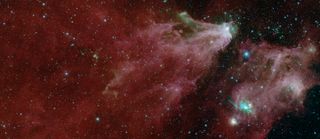With End in Sight, Spitzer Space Telescope Releases Glorious Nebula Images
NASA has released a stunning pair of images taken by the Spitzer Space Telescope, an instrument the agency will be shutting down on Jan. 30, 2020.
The Spitzer Space Telescope, which has been at work since 2003, sees the universe in infrared light. For the past decade, the observatory has been hindered because it ran out of coolant, but the instrument still offers a valuable window into the early history of the universe.
Because of its infrared sensitivity, Spitzer can get a stunning look at nebulas, the clouds of dust and gas peppered throughout the universe. The puffy green structures in the newly released image are nebulas, with stars scattered within them, including a cluster called Cepheus C on the left and one called Cepheus B in the upper right corner, according to a NASA statement.
Related: Happy Birthday, Spitzer! NASA Telescope Marks 15 Years in Space
Also on display in the image are a star cluster and pillar, from which the left-hand nebula appears to be emanating. The two very bright spots close together toward the bottom right of the image represent a young nebula. And above those, the red arc represents a shock wave of gas created by the blue star below it, a so-called runaway star.
The green-tinted image draws on data gathered by two of Spitzer's instruments, but only one of them is still working today; the other needed to be kept cool and has been offline since 2009. Comparing Spitzer's view of Cepheus C and B taken with and without that instrument shows the impact of the coolant loss. When lacking the second instrument, Spitzer can't see the runaway star, nor a massive star that forms a reddish hourglass shape in the middle of the left-hand nebula swath.

Spitzer's primary mission was designed to last only 2.5 years; the telescope kept working at full capacity for 3.5 years longer than that before running out of coolant. In a recent evaluation of the project, NASA decided to end the mission on Jan. 30, 2020, after an agency search for a private organization to take over the telescope turned up empty. Scientists are already mourning Spitzer's last days.
Get the Space.com Newsletter
Breaking space news, the latest updates on rocket launches, skywatching events and more!
"Spitzer enables groundbreaking advances in our understanding of planetary systems around other stars, the evolution of galaxies in the nearby and distant universe, the structure of our Milky Way galaxy, the infinite variety in the lives of stars, and the constituents of our solar system," Lisa Storrie-Lombardi, Spitzer's project manager, wrote in a blog post published on May 14. "I can assert with confidence that no one expected that the observatory would still be operating and doing exciting science in 2019."
That gives the telescope just eight months to squeeze in as many observations as possible. Of course, even after Spitzer turns off, scientists will be able to access the data it has gathered over the course of its career.
- 50 Fabulous Deep-Space Nebula Photos
- Gallery: The Infrared Universe Seen by Spitzer Telescope
- Zoom Through the Famous Orion Nebula with NASA's Incredible 3D Video
Email Meghan Bartels at mbartels@space.com or follow her @meghanbartels. Follow us on Twitter @Spacedotcom and on Facebook.
Join our Space Forums to keep talking space on the latest missions, night sky and more! And if you have a news tip, correction or comment, let us know at: community@space.com.

Meghan is a senior writer at Space.com and has more than five years' experience as a science journalist based in New York City. She joined Space.com in July 2018, with previous writing published in outlets including Newsweek and Audubon. Meghan earned an MA in science journalism from New York University and a BA in classics from Georgetown University, and in her free time she enjoys reading and visiting museums. Follow her on Twitter at @meghanbartels.
